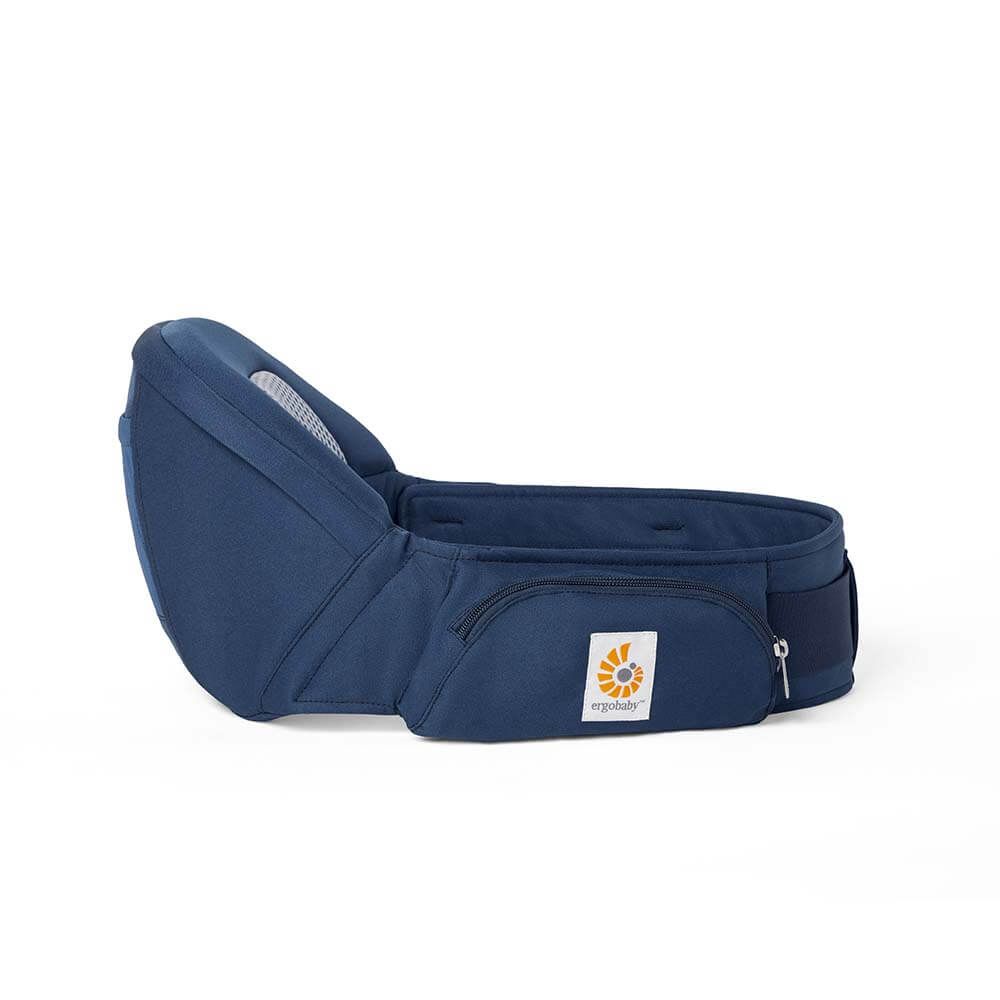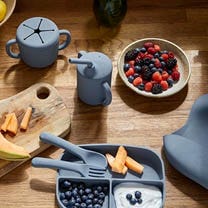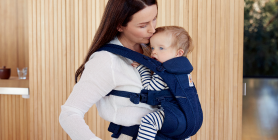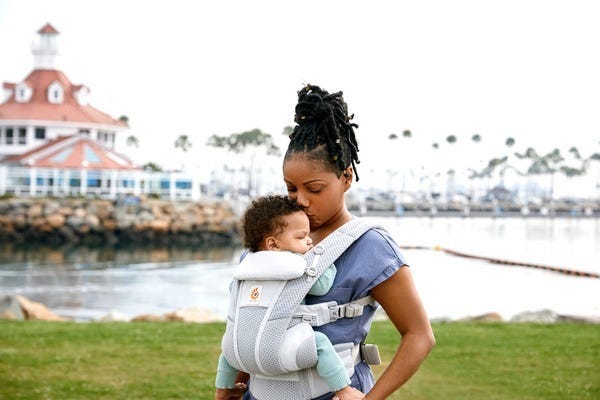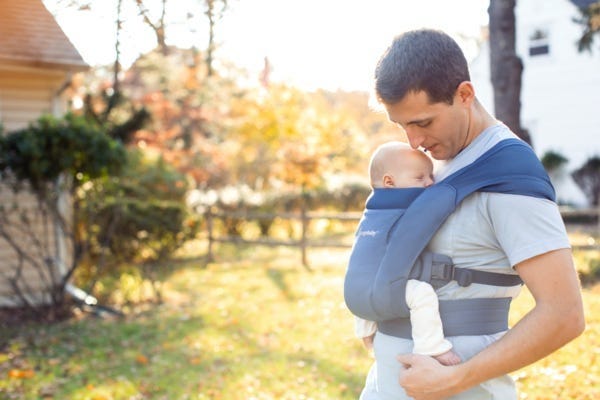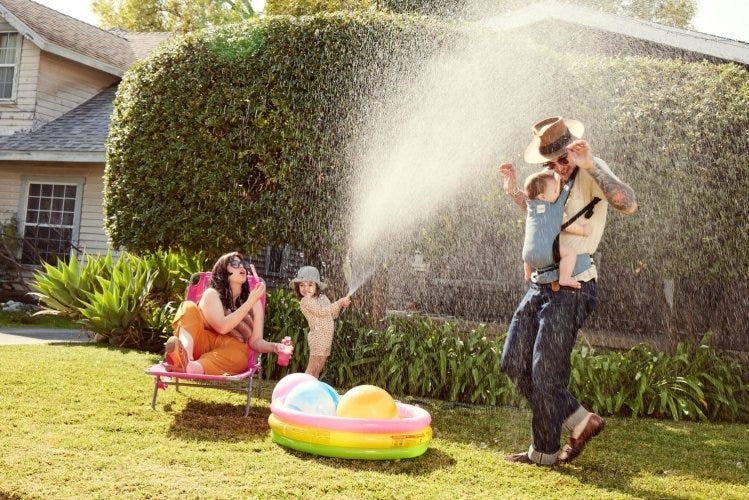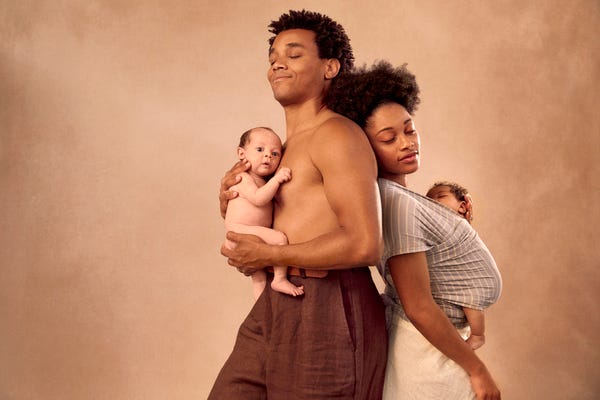
Every mom you know has probably told you that you’ll regret not using a baby carrier (I’m one of those moms). However, there are so many wraps out there, that it can be confusing for moms and dads to figure out what type of baby wrap to use much less how to use it. And you’ve likely heard or seen terms online like carrier, ring sling and infant wrap. These terms, and baby gear in general, can be really confusing. In this post, we’ll go over why you’d want a baby wrap, how to tie a baby wrap and tips for tying and using a baby wrap.
Why Should You Use a Baby Wrap?
If you’re like me, you can’t seem to make any big, or slightly big, decisions without drafting up a Rory Gilmore-style pro-con list. Here’s yours for a baby wrap carrier.
Pros:
1. Wraps are an ideal tool for early postpartum days
Baby wraps are an excellent choice for mamas in the early days postpartum. While several of our carriers are newborn friendly (like the Omni 360) and can be used from birth on up, a baby wrap like the Aura Baby wrap can be extra cozy and snuggly, especially in the early days postpartum where you’ll mostly be home, bonding, cuddling, feeding, and napping.
2. Bond with your baby during the fourth trimester
The benefits of holding baby close to you are many. The fourth trimester refers to the first three months after birth and it’s when your little one is moving from the familiar comfort of your warm, dark womb to a new environment full of unfamiliar sights, sounds, smells, and sensations. At this time, baby is adjusting to a time of enormous change and development. Babywearing and baby wraps in particular can help support this transition for baby by keeping baby close and connected to you. They need a lot of touch, containment, and holding. Whether wrapped up in a baby wrap or in a carrier, babywearing promotes that critical bond between you and your child during the days that matter most. Babywearing allows you to stay connected and close throughout the day and attuned to baby’s cues and needs.
3. Kangaroo Care or skin-to-skin is easily accessible with the Aura Baby Wrap
The benefits of skin to skin contact are innumerable. Essentially, this means holding baby skin to skin against mother (or father’s) chest. “Skin to skin contact has been demonstrated as key component to help a baby regulate his heart and breathing rate, maintain body temperature, gain weight, enhance his immune system, spend more time in deep, restful sleep, and while awake it can aid in more quiet and alert time, fewer crying hours and make him more amenable to breastfeeding.
4. Baby wraps are comfortable, snuggly, and soft
If you haven’t tried our Aura Baby Wrap, the material is soft, cozy, and lightweight. Depending on the type of birth experience you’ve had (such as a C-section or for anyone those first 40 days), the bulkiness of a carrier waist belt or a large buckle may not be ideal right away as your body and skin are healing. The soft material of the baby wrap may be ideal for you and won’t put too much pressure around your waist or any scarring you may have. The compression of the wrap may even feel supportive and helpful or you can try tying off the wrap above your incision if you’ve had a C-section.
5. Leave the wrap on while running errands
While you can’t leave baby in the wrap in the car for obvious reasons, you can wear your wrap like a fashion statement and keep it ready to go for baby. It’s comfortable to wear you can easily leave it on and ready for baby as you go out and about without having to take the full wrap on and off.
6. Hands-free
This is really a benefit of any baby carrier, but freeing up your hands to around the house or out in the world is one of the most brilliant aspects of babywearing.
Cons:
Not always ideal for older babies
As babies grow older, their increased weight and boundless curiosity about the world might pose a slight challenge when using baby wraps. Maneuvering an active, more substantial little one into a wrap can initially seem a tad more intricate than with a newborn. However, with adaptable wrapping techniques and a bit of adjustment, caregivers can tailor the wrap to accommodate the growing baby's weight and restless energy.
There’s a learning curve
Mastering the art of using baby wraps often comes with a gentle learning curve, much like tying the perfect knot or finding the ideal snug fit. Initially, it might feel like navigating uncharted waters, but with practice, patience, and a sprinkle of trial and error, caregivers soon find their rhythm, turning those initial fumbles into confident, graceful wraps that cocoon their little one with ease. The learning curve evolves into a journey of discovery, transforming uncertainties into a skillful dance of comfort and closeness between parent and baby.
How to Tie a Baby Wrap
Let’s address one of the main cons in the above list and talk more about how to tie a baby wrap. Compared to soft-structured baby carriers (ones with padded straps and a waist belt) or even a ring sling (long, rectangular piece of cloth with two rings sewn into an end), baby wrap carriers (a long piece of rectangular fabric wrapped entirely around the caregiver’s and baby’s bodies and tied to secure it) typically take a little more time and practice to get used to correctly tying for first-time baby wrap users. But once you get the hang of it, tying a wrap will become second nature to you. While you can use different carrying positions with most baby wraps—front inward facing, hip carry and back carry for example—the most common position is the front inward facing carry, especially for newborns. This easy-to-follow video visually guides you through these steps so you can watch to make sure you’re correctly tying your Ergobaby Aura Baby Wrap.
Front Inward Facing Carry Instructions
- Unfold the wrap and find the center of it.
- Place the center of the wrap on your body (across or just under your chest) and gather the top half of the fabric.
- While holding the wrap, cross your hands behind your back and then pull them up to tighten the wrap and over your shoulders. This should form an “X” across your back.
- Gather the fabric, tuck it through the top half of the fabric that’s around the center on the front of your body and then cross it in front of you down by your waist. You should now have an “X” high on your chest. The higher the “X”, the higher on your chest your baby will sit.
- Tie the baby wrap around your waist in a double knot. You can tie it in the front, on your side or behind your back, wherever you feel most comfortable. Depending on your size and length of the fabric, you might wrap it around your waist once or a couple of times.
- Check the front to make sure you left enough space for your baby, about 6-8 inches. Also, check the neckline to make sure it’s in the right place and that the fabric feels secure and comfortable over your shoulders.
- Now it’s time to pick up your baby!
- Lay your baby, who’s facing you, against you over your side and shoulder that’s opposite of the wrap’s inside panel (the one closest to your body). Put his leg in through the inside panel first and then his other leg in through the other panel, or outside panel.
- You now have an X-seated position for your baby, and you’re going to pull the inside panel over his back so it’s all the way across, knee to knee, on the bottom. His back, bottom and thighs should be covered by the inside panel.
- Now repeat step 10 with the outside panel. After both panels are pulled across his back, double check that he is sitting ergonomically in an M-shape position.
- Take both of baby’s legs and put them through that outside, horizontal panel (the one across your body that you pushed down earlier) and pull it up all the way until it’s under baby’s neck.
- Lastly, tuck the bottom under his knees to make sure he’s still in the M-position and that your baby is comfortably and safely inside the wrap.
This easy-to-follow video visually guides you through these steps so you can watch to make sure you’re correctly tying your Ergobaby Aura Baby Wrap.
Emotional Benefits of Getting Outside
Spending time in nature with your baby can strengthen the bond between you. The simple act of holding your baby close, feeling their warmth, and sharing new experiences together can create strong emotional connections. It’s also a wonderful way to reduce stress and improve your mood. When my littles were extra fussy, I’d take a walk around the neighborhood. Even though I don't live in an area with trails and surrounded by nature, simply behind outside changed everything. A little vitamin D does wonders!
Cognitive Development
Nature is a sensory wonderland for babies. The different sights, sounds, and smells can stimulate your baby’s senses and promote cognitive development. Watching leaves rustle, hearing birds chirp, and feeling the texture of a tree bark can all contribute to their learning and development.
Choosing the Right Baby Carrier
When it comes to selecting the best baby carrier for summer adventures, there are several options to consider.
Types of Baby Carriers:
- Wraps: Perfect for newborns, providing a snug and secure fit.
- Slings: Ideal for quick and easy use, offering good ventilation.
- Soft Structured Carriers: Versatile and comfortable for both parent and baby, suitable for longer trips.
Factors to Consider:
- Baby’s Age and Weight: Ensure the carrier is appropriate for your baby’s size and weight. For example, Ergobaby’s Embrace Newborn Carrier is perfect for the fourth trimester where baby is small and you’re looking for an easy way to stay close. As they grow, you’ll want to upgrade to an all-position carrier that’s meant for growing babies.
- Parent’s Comfort and Ergonomics: Look for carriers with padded shoulder straps and lumbar support if you’re planning on longer outings.
- Ease of Use: Choose a carrier that is easy to put on and take off.
- Climate and Breathability: Opt for carriers made of breathable fabrics to keep you and your baby cool in hot weather.
Tips for Tying and Using a Baby Wrap
Ideal Spots for a Nature Walk with Baby
- Parks and Gardens: Great for leisurely walks and picnics.
- Nature Trails and Forests: Perfect for more adventurous outings.
- Beaches and Lakesides: Wonderful for enjoying the water and sand, with the right carrier.
Activity Ideas
- Hiking: Enjoy a scenic hike with a hiking baby carrier that offers support and storage.
- Bird Watching: Use your carrier to keep your baby close while you explore and observe wildlife.
- Picnics: A carrier can free up your hands, making it easier to carry picnic supplies.
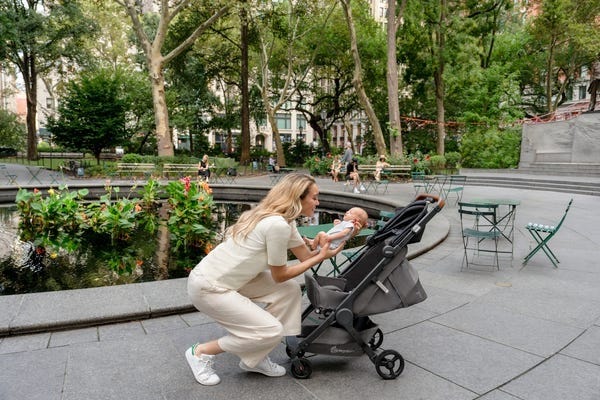

Advantages of Using Strollers for Nature Adventures
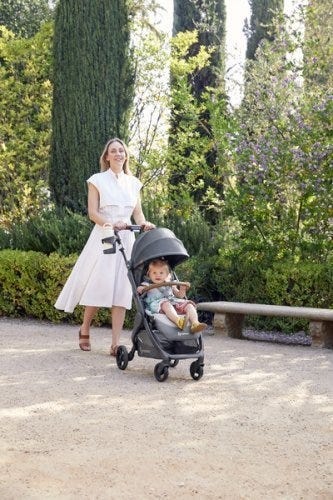

While baby carriers are fantastic for mobility and closeness, depending on the adventure of choice you might want to be a stroller along too.
There are a LOT of baby stroller options on the market. So we understand how confusing it can be to choose the one that’s right for your family. Not only are there a variety of brands, but a variety of strollers that serve different purposes.
There are a few types of strollers on the market:
- Full-sized stroller: This is typically the stroller parents thing of buying for all its versatility.
- Lightweight or umbrella stroller:These compact strollers are perfect for on-the-go adventures.
- Jogging stroller: Designed for parents who want to combine fitness with outdoor adventures.
- Double stroller: Designed for parents with multiple kids, especially twins.
- Car seat carrier: These strollers connect to a specific car seat. We don't typically recommend these as they can be unsafe for baby and uncomfortable for parents who are pushing.
Learn more about the types of strollers and which one would be best for you.
Choosing The Perfect Baby Wrap for You
Choosing the perfect baby wrap is a blend of personal preference and practical considerations. Start by considering the fabric—some prefer the softness of cotton, while others opt for the elasticity of bamboo or the support offered by linen. Assess your lifestyle too; if you're constantly on the move, a lightweight, breathable wrap might suit you best, whereas a sturdier one could be ideal for longer carrying sessions. Pay attention to the wrap's length and width, ensuring it accommodates your body size and allows for the wrapping styles you prefer. Lastly, explore the designs and patterns available—beyond aesthetics, these can also guide you in understanding the wrap's different tying options and versatility. Ultimately, the best baby wrap is the one that aligns with your comfort, lifestyle, and bonding needs, facilitating a seamless and delightful experience for both you and your little one.
Tips and Tricks to Using a Baby Carrier
- Now that you know how to tie a baby wrap, here are some tips so you can know for sure that you and your baby will be safe and comfortable while using a baby wrap:
- Make sure the wrap is snug and comfortable for both of you. If the wrap doesn’t feel right, do three things: 1) Undo the wrap (without your baby in it) and tighten it. 2) Make sure the straps across your back are in a flat “X” position. 3) Be sure the “X” on your back is in the center of your back or up a little higher if you’re carrying a bigger baby.
- Make sure you have the right size. A question you might have when looking at baby wraps is, “What size of baby wrap do I need?” If you’re looking at a woven wrap, they come in basic sizes of size 1 up to size 8. Determining what size of baby wrap you need depends on the type of carries you plan to do, the fabric’s blend or thickness, what size you are and the size of your baby. But with other wraps, like the Aura Baby Wrap, you don’t have to worry about sizing. The Aura is a one size wrap that fits petite to plus-size wearers.
- Check and see if you can fit two fingers underneath your baby’s chin. Her chin needs to be up off her chest so her airways remain open to breathe.
- Always check that you can see your baby’s face. Whether your baby is awake, asleep or nursing, and even if your wrap is made of lightweight fabric, you don’t want her face smashed against your body or any fabric over her face. Gently turn your baby’s face to one side so it’s not pressed against you and move the fabric so it’s positioned off her face every time she’s in the wrap.
- Make sure your baby’s head, neck and back are totally supported with the wrap.
- She should be close against your body, not leaning away from you, with her back in a “C” position and her legs in an “M’ position.
- She should be high enough on your chest that you can lean down and kiss the top of her head.
- Remember it may take a minute or a few tries before your baby likes or feels comfortable in the wrap. So if your baby is fussy when you put her in, do your best to soothe her by softly bouncing, rocking back and forth, rubbing her back and/or quietly talking to her, and be kind and give yourself and her enough time to get used to it.
As your baby gets older, you can try out the other baby wrap carry positions with an all-position carrier.
Hip carry is best for babies who are around 5-6 months old and older who have good head and neck control.
The back carry with a baby wrap is not a recommended carry position for infant wrap use because the infant’s head and neck wouldn’t be supported. It’s best to try out the back carry when your child is around 1 year old and has great head, neck and upper body control. Or better yet, use a soft-structured carrier that’s made for safe, supportive back carrying. If you’re in the market for a versatile carrier, be sure to take a look at the offerings from Ergobaby.
Combining Baby Carriers and Strollers
For the ultimate flexibility, consider using both a baby carrier and a stroller on your outings.
Combining both options allows you to adapt to different situations. Use the carrier for more rugged trails and switch to the stroller for smoother paths or when your baby needs a nap.
Transition Tips
- Smooth Transitions: Plan stops where you can easily switch from carrier to stroller.
- Pack Light: Only bring essentials to make transitions easier.
Tips for a Successful Adventure
Planning Ahead
- Route Planning: Choose baby-friendly trails and parks. Check local mom groups or outdoor groups and get recommendations for the best outings for kids.
- Check Weather Conditions: Avoid extreme heat or unpredictable weather. Even with our most breathable carriers, when it’s hot, it’s hot. And having two bodies against each other in the heat will be naturally hot and sticky already.
- Packing Checklist: Include diapers, snacks, water, sunscreen, and a first-aid kit. These all-position carriers have storage pockets where you can fit some of the items easily!
- Stay Hydrated and Nourished: Pack healthy snacks to keep energy levels up and bring plenty of water for both you and baby.
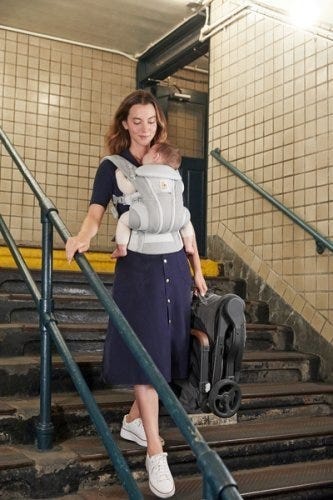

Summer adventures with your baby are a wonderful way to create lasting memories and enjoy the beauty of nature together. From baby carriers to strollers, Ergobaby products are designed to provide comfort and ease for both you and your little one. So, gear up, get outside, and explore the world with your baby by your side.
Ready to embark on your own summer adventures? Check out Ergobaby’s range of baby carriers and strollers to find the perfect match for your family’s needs. Visit our website today and start planning your next outdoor excursion!





